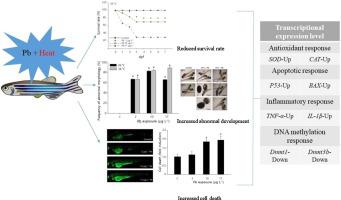当前位置:
X-MOL 学术
›
Aquat. Toxicol.
›
论文详情
Our official English website, www.x-mol.net, welcomes your
feedback! (Note: you will need to create a separate account there.)
Effects of thermal stress-induced lead (Pb) toxicity on apoptotic cell death, inflammatory response, oxidative defense, and DNA methylation in zebrafish (Danio rerio) embryos.
Aquatic Toxicology ( IF 4.1 ) Pub Date : 2020-05-08 , DOI: 10.1016/j.aquatox.2020.105479 Kiyun Park 1 , Eui Jeong Han 2 , Ginnae Ahn 2 , Ihn-Sil Kwak 3
Aquatic Toxicology ( IF 4.1 ) Pub Date : 2020-05-08 , DOI: 10.1016/j.aquatox.2020.105479 Kiyun Park 1 , Eui Jeong Han 2 , Ginnae Ahn 2 , Ihn-Sil Kwak 3
Affiliation

|
Lead (Pb) is a toxic environmental pollutant that is frequently present in effluents from urban, mining, and industrial sources. The combinatorial effects of heavy metal exposure and temperature in aquatic organisms have received considerable attention as heat stress occurs simultaneously in conjunction with several contaminants in a natural environment. In this study, we examined the potential effects of Pb exposure in conditions of thermal stress (34 °C) in zebrafish (Danio rerio) embryos. Thermal stress at 34 °C induced a dramatic decrease in the survival rate, although exposure to Pb at 26 °C decreased the survival rate of the embryos. Malformations, such as the curved body shape, were increased in response to exposure to a combination of Pb and heat stress. The combination of Pb and heat stress also caused a decrease in the heart rate. Moreover, Pb and high-temperature exposure induced the upregulation of SOD, CAT, TNF-α, IL-1β, p53, and BAX transcripts, and downregulation of Dnmt1 and Dnmt3b transcripts. Thermal stress enhanced transcriptional responses of eight indicator genes following Pb toxicity. The induction of cell death in response to combined exposures was also confirmed in the body of zebrafish by fluorescence intensity image analysis. These data indicated that thermal stress enhanced the poisonous effects of Pb exposure on antioxidant defense, inflammation, and apoptotic mechanisms. Transcriptional inhibition of DNA methylation-related genes might serve as a crucial factor contributing to the possibility of epigenetic adaptation by altering combined stress. We suggest that a careful evaluation of the potential effects of climate change (especially temperature) should be considered when investigating the toxic levels of metal pollution, such as Pb, in an aquatic environment.
中文翻译:

热应激诱导的铅(Pb)毒性对斑马鱼(Danio rerio)胚胎中凋亡细胞死亡,炎症反应,氧化防御和DNA甲基化的影响。
铅(Pb)是一种有毒的环境污染物,经常存在于城市,采矿和工业来源的废水中。由于热应力与自然环境中的几种污染物同时发生,重金属暴露和水生生物中温度的组合效应已引起相当大的关注。在这项研究中,我们研究了斑马鱼(Danio rerio)胚胎在热应激(34°C)条件下Pb暴露的潜在影响。尽管在26°C下暴露于Pb会降低胚胎的存活率,但在34°C的热应力下会导致存活率的急剧下降。响应于暴露于Pb和热应力的组合,畸形(例如弯曲的身体形状)会增加。铅和热应激的结合也导致心率降低。此外,铅和高温暴露诱导SOD,CAT,TNF-α,IL-1β,p53和BAX转录本的上调,以及Dnmt1和Dnmt3b转录本的下调。铅毒性后,热胁迫增强了八个指示基因的转录响应。还通过荧光强度图像分析在斑马鱼体内证实了响应于组合暴露引起的细胞死亡诱导。这些数据表明,热应激增强了Pb暴露对抗氧化剂防御,炎症和凋亡机制的毒性作用。DNA甲基化相关基因的转录抑制可能是通过改变综合压力而促进表观遗传适应的关键因素。
更新日期:2020-05-08
中文翻译:

热应激诱导的铅(Pb)毒性对斑马鱼(Danio rerio)胚胎中凋亡细胞死亡,炎症反应,氧化防御和DNA甲基化的影响。
铅(Pb)是一种有毒的环境污染物,经常存在于城市,采矿和工业来源的废水中。由于热应力与自然环境中的几种污染物同时发生,重金属暴露和水生生物中温度的组合效应已引起相当大的关注。在这项研究中,我们研究了斑马鱼(Danio rerio)胚胎在热应激(34°C)条件下Pb暴露的潜在影响。尽管在26°C下暴露于Pb会降低胚胎的存活率,但在34°C的热应力下会导致存活率的急剧下降。响应于暴露于Pb和热应力的组合,畸形(例如弯曲的身体形状)会增加。铅和热应激的结合也导致心率降低。此外,铅和高温暴露诱导SOD,CAT,TNF-α,IL-1β,p53和BAX转录本的上调,以及Dnmt1和Dnmt3b转录本的下调。铅毒性后,热胁迫增强了八个指示基因的转录响应。还通过荧光强度图像分析在斑马鱼体内证实了响应于组合暴露引起的细胞死亡诱导。这些数据表明,热应激增强了Pb暴露对抗氧化剂防御,炎症和凋亡机制的毒性作用。DNA甲基化相关基因的转录抑制可能是通过改变综合压力而促进表观遗传适应的关键因素。











































 京公网安备 11010802027423号
京公网安备 11010802027423号